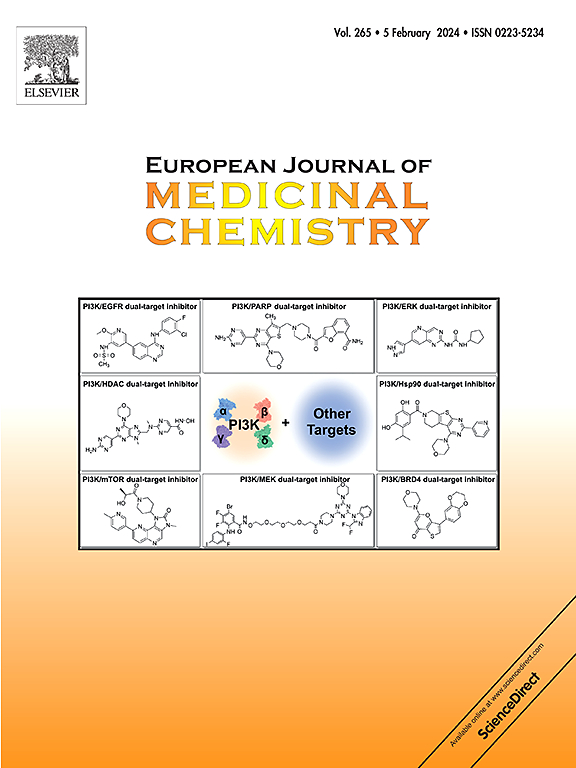Design, synthesis, and biological evaluation of quinolinyl-ureido-phenyl-hydrazide derivatives and quinolinyl-hydrazide derivatives as anticancer agents targeting Nur77-mediated ferroptosis
IF 6
2区 医学
Q1 CHEMISTRY, MEDICINAL
引用次数: 0
Abstract
In the recent decade, targeting ferroptosis for cancer therapy has attracted remarkable attention. Interestingly, the transcriptional regulator Nur77, a promising therapeutic target in cancer, has been recently identified as a crucial regulator of ferroptosis. However, no ferroptosis inducer targeting Nur77 has been reported currently. In this study, we built upon our prior research on Nur77 modulator 4-PQBH to design and synthesize four series of new compounds, with the objective of developing novel Nur77-mediated ferroptosis inducers. Among them, compound 8f exhibited the most potency against the tested cancer cell lines, including human estrogen positive breast cancer and triple-negative breast cancer cell lines, while displaying lower toxicity towards human normal cell lines HaCaT and MCF-10A (IC50 > 50 μM). Furthermore, 8f demonstrated superior Nur77-binding activity in comparison to the reference compound Csn-B, and it has the capacity to activate the Nur77-driven luciferase activity and increase the protein level of Nur77. Remarkably, 8f induced an increase in the levels of reactive oxygen species (ROS), malondialdehyde (MDA), and lipid peroxidation, concurrently with a reduction in the expression of GPX4 protein, culminating in the induction of ferroptosis in a Nur77-dependent manner. In vivo, 8f treatment has been observed to significantly suppress MCF7 xenograft tumor growth. Consequently, a novel ferroptosis inducer targeting Nur77 (8f) is first reported as a potent anti-EPBC agent, providing may serve as a promising lead for further drug development targeting Nur77-mediated ferroptosis.


喹啉脲基苯基酰肼衍生物和喹啉酰酰肼衍生物作为靶向nur77介导的铁凋亡的抗癌药物的设计、合成和生物学评价
近十年来,针对铁下垂的癌症治疗引起了极大的关注。有趣的是,转录调节因子Nur77是一种很有前景的癌症治疗靶点,最近已被确定为铁下垂的关键调节因子。然而,目前尚无针对Nur77的铁下垂诱导剂的报道。在本研究中,我们在之前对Nur77调节剂4-PQBH的研究基础上,设计并合成了四个系列的新化合物,目的是开发新的Nur77介导的铁下垂诱导剂。其中,化合物8f对人雌激素阳性乳腺癌和三阴性乳腺癌细胞系的抑制作用最强,对人正常细胞系HaCaT和MCF-10A (IC50 >;50μM)。此外,与对照化合物Csn-B相比,8f具有更强的Nur77结合活性,能够激活Nur77驱动的荧光素酶活性,提高Nur77的蛋白水平。值得注意的是,8f诱导活性氧(ROS)、丙二醛(MDA)和脂质过氧化水平的增加,同时GPX4蛋白表达的减少,最终以nur77依赖的方式诱导铁死亡。在体内,已观察到8f治疗可显著抑制MCF7异种移植物肿瘤的生长。因此,一种针对Nur77 (8f)的新型铁下垂诱导剂首次被报道为一种有效的抗epbc药物,可能为进一步开发针对Nur77介导的铁下垂的药物提供了有希望的线索。
本文章由计算机程序翻译,如有差异,请以英文原文为准。
求助全文
约1分钟内获得全文
求助全文
来源期刊
CiteScore
11.70
自引率
9.00%
发文量
863
审稿时长
29 days
期刊介绍:
The European Journal of Medicinal Chemistry is a global journal that publishes studies on all aspects of medicinal chemistry. It provides a medium for publication of original papers and also welcomes critical review papers.
A typical paper would report on the organic synthesis, characterization and pharmacological evaluation of compounds. Other topics of interest are drug design, QSAR, molecular modeling, drug-receptor interactions, molecular aspects of drug metabolism, prodrug synthesis and drug targeting. The journal expects manuscripts to present the rational for a study, provide insight into the design of compounds or understanding of mechanism, or clarify the targets.

 求助内容:
求助内容: 应助结果提醒方式:
应助结果提醒方式:


